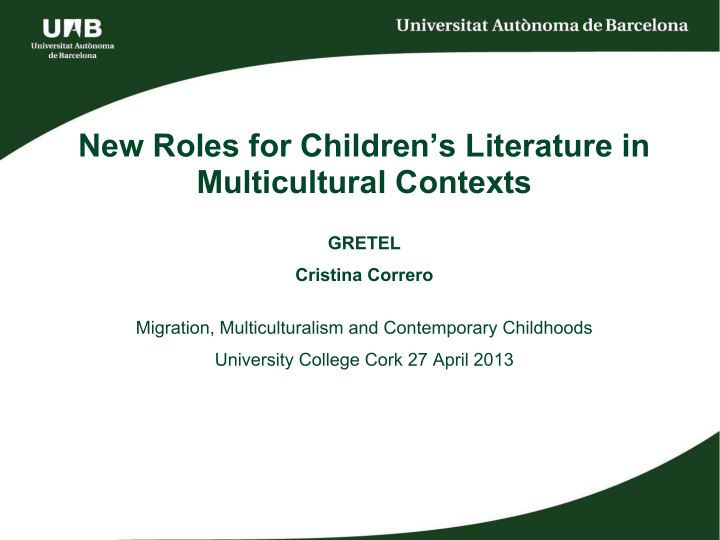



New Roles for Children’s Literature in Multicultural Contexts GRETEL Cristina Correro Migration, Multiculturalism and Contemporary Childhoods University College Cork 27 April 2013
Research group on Books for Children and literacy GRETEL learning from Universitat Autònoma Barcelona Children's literature roles/ uses, Literacy Education, Picture Research areas books analysis and other metafictional learning, reading habits on paper and screen Dr. Teresa Colomer (Main researcher) + 16 Members other lectures, fellows and contributors www.gretel.cat www.literatura.gretel.cat Web sites
Our expertise in Children's literature Books for early readers ■ Metafictional books analysis ■ Effects of specific themes in building interpretative images in readers ■ Folktales in the XXI & transmediation btw texts, images & audios ■ Aspects of ideological analysis: gender, multiculturalism ■
Literary education at school Teaching ■ Literary work projects ■ Interpretation as a learning collaborative ■ School programmes for literary education ■ Reading promotion programmes ■ Reading habits and training of teachers ■ Digital uses in literary educations ■
Research projects granted Teacher's training ■ Youngster's reading habits ■ Picturebooks ■ Symposium & European Stockholm 2013 Projects “Text, image, ■ ideology. Barcelona 2007 Picturebooks as ■ Glasgow 2009 meetingplaces” ■ Tübingen 2011
Visual Journeys Understanding immigrant children's responses to the visual image in contemporary picture books UAB, Columbia, Glasgow UAB, Columbia, Glasgow
R&D Project: “Literary Interpretation of Picturebooks in the Introductory Process of Immigrant Children” Funded by Ministry of Education and Science 2009-2011 I+D: EDU2008-02131/ EDUC 2008- 2012 Visual Journeys/ Arie/00003 AGAUR
Main Objectives Analyse and classify book production dealing with migration and 1. intercultural issues to establish selection criteria. Describe and classify existing literary activities in the first phase of 2. integration Analysing literary activities to language acquisition 3. Exploring interpretations made by immigrant children and personal 4. experience, cultural traditions and practices. Compare interpretative results between different groups with their attitudes 5. towards intercultural coexistence Compare the findings with the other international research. 6.
Methodology ■ Reading and discussion of picturebooks ■ Shared meaning discussions ■ Link reading with writing, creative writing and theatre
Phase ■ Realisation phase ○ Schools: 4 primary + 5 secondary ○ 108 Pupils, from 19 countries ■ Selection ○ Picturebooks ○ Questionnaires ■ Process
O1: Editorial Production Features Describe and analyse current books production ■ Determine the educational values promoted ■ to address migration issues
About value analysis About the corpus and their new roles ■ To build their own identity: ■ Events described ○ Emotions and intimate reflection ○ Perspective ○ Get used with the poetic register ○ Focalisation ○ Participation in ludic dimension of language ○ Causes of migration ○ Projection of the migration's experience ■ Homeland image ○ Reflection about individual differences ■ Narrative forms used ○ Intercultural recognition ■ Relationship b/w the two realities ■ Language learning: ○ Oral purposes ○ Acquiring vocabulary ○ Acquiring reading and interpretative strategies ○ Improve understanding
Types of Children's books that are most helpful Multilingual books ■ Translations and anthologies ■ Books with updated social representations of characters and situations ■ Books in immigration issues ■ Books based on orality ■ Books based on imagery ■
Examples: ■ Greder, Armin: The island ■ Lofthouse, Liz: Ziba came on a boat ■ Müller, Jörg: The steadfast tin soldier ■ Revorvirts, Helen: My name is Yoon ■ Schimel, Laurence: Let's go to see Papá! ■ Sis, Peter: Madlenka ■ Tan, Shaun: The arrival ■ Randa Abdel- Fattah, Marion: Does my head look big in this? ■ Sellier, Marie: Africa, little Chaka ■ Ruillier, Jerome: Four little corners
O2. School teaching practices ■ Analysis of teacher's representation: questionnaires and interviews. ■ Observations in ten classrooms: literary activities
Activities full of possibilities ■ Oral storytelling and use of folklore ■ Dramatisation of short texts ■ Collective discussions about the meaning of stories ■ Picturebooks
Explore Literature's New Roles ■ To learn new language ■ Increase interpretative abilities ■ Take profit of migratory experience to enhance intercultural education
The project has helped to ■ Increase our knowledge about reception and interpretative capacity of visual and textual narratives, ■ Identify new interpretative categories , ■ Identify and describe new shared meaning processes , ■ Define the role of the mediator , ■ Set up new teaching models for this pupils: types of activities, corpus, new forms of mediations to improve current practices
The UK's novelists on the 2013 Granta List “Multicultural mix” BBC
Thank you! gretel@uab.cat
Recommend
More recommend